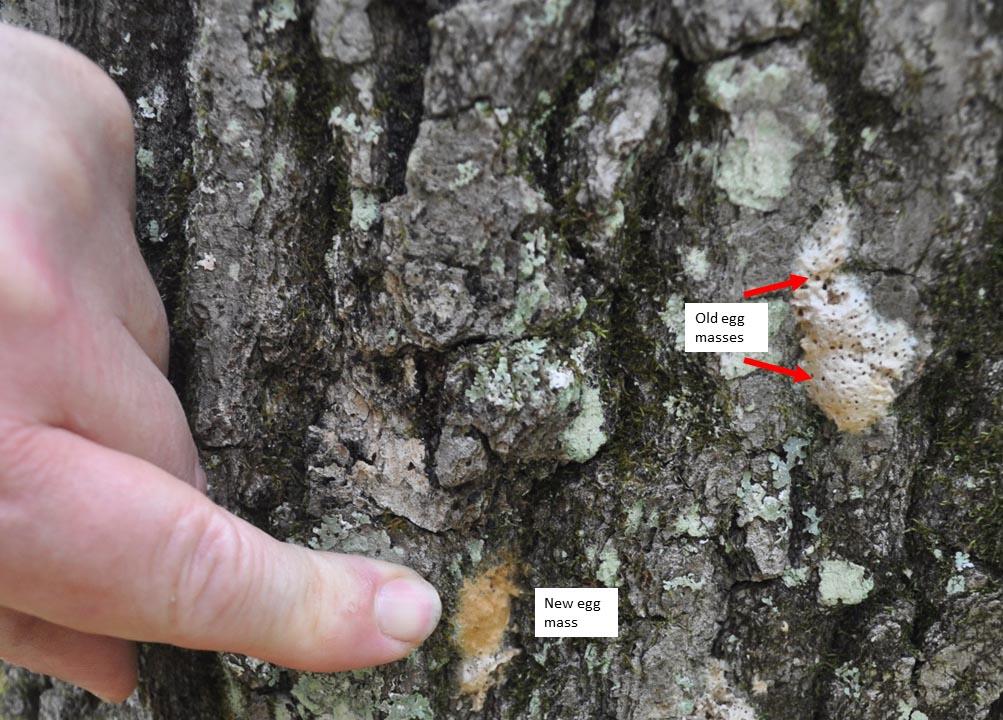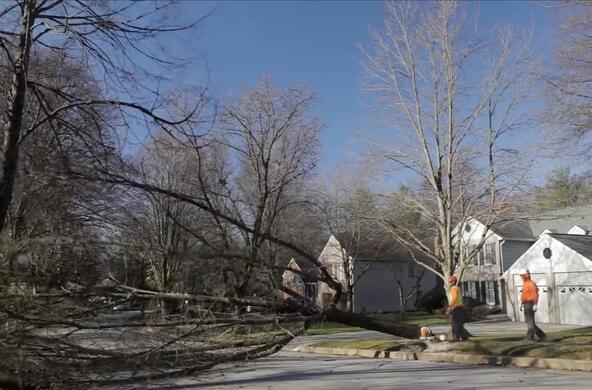By: Clive G. Jones1, Michael J. Fargione1 and Julie E. Hart2
Key takeaways
If the trees in your yard …
- Were defoliated by the spongy moth in 2023 AND 2024, then the outbreak has very likely collapsed and you should not expect any defoliation in 2025.
- Were defoliated ONLY in 2024, then although the outbreak is nearing its end, and there could still be some defoliation 'hot spots' in 2025, widespread defoliation is unlikely.
- Were not defoliated in either of the last two years, they have very likely escaped this spongy moth outbreak!
- Were defoliated in 2023 but NOT in 2024, then they survived the outbreak and should be on their way to full recovery!
| Cary Institute | Central & Eastern Dutchess County | Hudson Valley |
| Western Dutchess County | Spongy moth resources | |
| Dutchess County-wide summary |
The invasive, introduced spongy moth defoliated trees in many areas of the Hudson Valley in 2023 and in 2024. Last year was particularly notable. In early May of 2024, a huge number of recently hatched caterpillars dispersed by ballooning on silken threads into new areas, while also causing skin irritation when they landed on people not trees. In many places there were high levels of defoliation — as much as 100% for oaks.
Here we revisit what happened in 2024 at Cary Institute of Ecosystem Studies in Millbrook, then look at the situation for central and eastern Dutchess County, western Dutchess County, and the rest of the Hudson Valley. What happened? What will happen next? Is the spongy moth outbreak over or will it continue?


Spongy Moth at Cary Institute
In 2024, we experienced the ballooning and defoliation at Cary Institute, but we also saw a lot more. The wet spring combined with abundant caterpillars led to an epidemic of a fungus that killed many larvae. A virus that is lethal when caterpillars are stressed by lack of food then killed many of the remaining larvae. Of the few that survived the fungal and viral onslaught, many later succumbed to starvation.


Few female caterpillars survived to become egg-laying adult moths. The egg masses that were laid were smaller in size than usual, likely due to female caterpillars having insufficient food to lay a full complement of eggs as adults.

The few new egg masses produced in 2024 now show many emergence holes from small parasitic wasps that lay eggs in spongy moth eggs. This will further depress the number of eggs that will hatch in late April/early May 2025. Those caterpillars will enter a world now full of natural enemies — parasites and predators — many of which have had time to build up in numbers as the outbreak has progressed. If you are a spongy moth at Cary Institute, your current prospects do not look good, especially compared to three years ago when things were rosy! What we saw is not unusual. Our observations well describe how outbreaks of the spongy moth generally come to an end.
What about elsewhere in the county?

Spongy moth in Dutchess County
Central & Eastern Dutchess County
Cary Institute is in the Town of Washington, in central Dutchess County. We have some observations from nearby townships (Stanford, Union Vale, Clinton, Pleasant Valley and Milan) that also indicate that the outbreak is ending.


As can be seen in the New York State Department of Environmental Conservation (DEC) spongy moth defoliation aerial surveys above, a number of areas in eastern and central Dutchess County were reported as experiencing two back-to-back years of defoliation, as was the case at Cary Institute and the above listed towns. Two back-to-back years of defoliation may well have been enough to end the outbreak, especially given the assistance of the fungal epidemic seen last year in a number of locations. So this situation may also apply to Union Vale, Dover, and La Grange, although we do not have observations for those areas. DEC did not report any defoliation in 2023 or 2024 for the Townships of Amenia or North East, and Pawling was reported as having some defoliation in a small area in the north in 2024 only, but again we have no observations for those towns. Without local observations we cannot do more than provide our general expectations for the center and east of the county — that the outbreak has collapsed or is collapsing and it is unlikely that there will be much if any defoliation in 2025.
Western Dutchess County
DEC reported little or no defoliation in 2023 in western townships of Red Hook, Rhinebeck, Hyde Park, Poughkeepsie, Wappinger, or Fishkill, but many areas in those towns had defoliation reported by DEC in 2024. So what about those areas with only one year of defoliation, or those that may have escaped any significant defoliation so far? Since the fungal epidemic of 2024 was, as far as we know, quite widespread, was that enough to put an end to the outbreak? Or should Western Dutchess County be prepared for more defoliation?
Towns of Red Hook and Rhinebeck
To help try and answer this question, we examined trees in the Townships of Red Hook and Rhinebeck at the beginning of March this year, before egg masses hatch in late April/early May. Only a small portion of southeastern Red Hook was reported by DEC as being defoliated in 2023 and no defoliation was reported in 2023 for the town of Rhinebeck. In 2024, DEC reported more extensive defoliation in the eastern areas of both townships; patchy defoliation in the central and southern areas of both townships; but no defoliation in the far west along the Hudson River in either township. We sampled numerous (mostly) oak trees at nine locations across western, central, and eastern Red Hook and northwestern Rhinebeck, more or less from north to south. Information on specific locations can be found in our Red Hook 2025 Spongy Moth Prognosis.
In southeastern Red Hook our survey indicated outbreak collapse with a low likelihood of any significant defoliation in 2025. This was also the case in the adjacent, westward part of the Town of Milan where we already had observations. There were no or few new egg masses and many old egg masses that hatched in 2024. (Some egg mass remnants might even have hatched back in 2023.)
In central areas of Red Hook, one site that was not reported by DEC as having been defoliated in 2023 or 2024 had an isolated oak tree with sufficient new egg masses for defoliation, but no old egg masses. This might have been the result of immigration via ballooning on silk from other areas. Other trees at that site had no old or new egg masses. Two additional sites in central Red Hook, that were also not reported by DEC as being defoliated in 2023 or 2024 (one site was recorded by us as having a low level of defoliation in 2023) had ongoing outbreaks with many new egg masses and some indications of old masses (remnants) in plantations of scarlet oaks. These locales appear likely to experience significant defoliation in 2025. So in contrast to the east where the outbreak seems to have collapsed, the outbreak in this area of central Red Hook appears to be ongoing.
In northwest Red Hook, two sites that were not reported as defoliated by DEC in 2023 or 2024 had a few new egg masses and a few old egg masses, hence a low likelihood of defoliation in 2025. There was no clear indication of an outbreak either increasing or collapsing. It is possible that the spongy moth in these areas was the result of immigration from the east and the future trajectory in those locales is uncertain; they may increase or peter out. In contrast, three other westerly sites reported by DEC as having been defoliated in 2024 differed considerably. One site in southwest Red Hook showed signs of population collapse with few new egg masses and many old egg masses. A second site in northwest Rhinebeck indicated imminent collapse with many new and many old egg masses but with potential for some 2025 defoliation. A third site in northwest Rhinebeck indicated new establishment via larval immigration onto isolated oak trees with potential for localized defoliation (some to many new masses, no old masses). Overall, these western locations varied considerably from place to place with respect to the state of the moth population, its trajectory and the likelihood of 2025 defoliation. Nevertheless, it appears that areas reported by DEC as being defoliated in 2024 are more likely to have collapsed or be collapsing than areas that were not reported as having been defoliated in 2024 or 2023.
It is worth noting that we found evidence of high levels of egg parasitism by the wasp Ooencyrtus kuvanae at all locales. This was expected. Although it takes two to three years for the wasp population to catch up with the spongy moth population, eventually it does, and it then contributes to the downfall of the moth. So in contrast to egg masses at the start of a region-wide outbreak that have low levels of egg parasitism, egg masses toward the end of a region-wide outbreak will now have high levels of egg parasitism. In addition, the now large populations of the wasp and other insect parasites of larvae and pupae are highly mobile, which bodes well for them to get to otherwise isolated moth populations and contribute to their demise.
Dutchess County-wide summary
We do not have data for other towns in the west. Nevertheless, it seems likely that other western townships (Hyde Park, Poughkeepsie, Wappinger, and Fishkill) may well have the same mix of situations that we saw in Red Hook and Rhinebeck. Central and western areas of these western townships will likely be more variable from locale to locale compared to the eastern areas.
All in all, our observations suggest an east to west pattern in Dutchess County, albeit quite variable in space. The outbreak in the East is generally collapsed or collapsing. The center is collapsed or collapsing or still ongoing in some locales. The West is a mixture of locales that have low populations, building populations, populations with signs of imminent collapse, and collapsed populations. So in a sense, the West and center may reflect what has already happened in the East, while the current situation in the East reflects what will happen in the West and center. All spongy moth outbreaks come to an end!
Spongy Moth in the Hudson Valley
We do not have any observations for other locations in the Hudson Valley, but we can hazard a guess as to the status of the outbreak. Those locations that have experienced two back-to-back years of defoliation in 2023 and 2024 have either collapsed or will very likely collapse in 2025. Locales that received defoliation only in 2024 might persist for another year or so before collapse. Locales that have not yet had any defoliation but are near to areas that have had defoliation may have populations established via immigration that could grow or die out, as noted above. Our observation that two back-to-back years of defoliation is sufficient for outbreak collapse is not atypical; past outbreaks have shown the same pattern.
There are (at least!) two caveats to any forecasts to bear in mind. First, there is good reason to believe that in some locales in western Dutchess County, spongy moth was established in 2024 by larval immigration — ballooning on silk — from more easterly areas. So even if you have not yet experienced a spongy moth outbreak with defoliation in your area and you see no new egg masses, downwind immigration from an out-breaking area can get an outbreak started in your neighborhood if enough larvae arrive and if enough survive. Second, a fungal epidemic depends on a wet spring and a moderate or high density of caterpillars. If an epidemic does occur in 2025, it will significantly reduce the larval population, potentially reducing defoliation and aiding moth population collapse. We are not weather forecasters, however, so any defoliation forecast needs to bear that in mind; things might be better than we expect, or not!
As the spongy moth outbreak winds down it is easy to just let it be an unpleasant memory, but let’s not forget about the trees. Those trees that received significant defoliation may be more susceptible to stress such as drought or diseases, but there are steps you can take to help them. Consult a knowledgeable arborist for best practices to help stressed trees. Feel free to check out the Spongy Moth Chronicles for information on spongy moth and tree health, and watch for our 2025 late spring update on how previously defoliated trees in the forest at Cary Institute are coping.
Finally, the spongy moth is just one of many introduced insect pests and pathogens in the Hudson Valley. You can help prevent more from arriving by lobbying your representatives to take action to help prevent further destructive onslaughts.
Clive G. Jones1 Michael J. Fargione1 and Julie E. Hart2
1 Cary Institute of Ecosystem Studies
2 Dutchess Land Conservancy
Please stay tuned for further information. Wishing you an upcoming season free from ballooning caterpillars and leafless trees!
Resources
Spongy moth chronicles
Observations on spongy moth activity in Cary forests throughout the 2024 season.
What you need to know about spongy moths: Q&A with Ecologist Clive Jones
The Spongy Moth in Our Yards and Forests
A fascinating and comprehensive look at this pest’s life history, ecology, and forest impacts.
Insect defoliation and nitrogen cycling in forests
Identifying spongy moth early larval instars








